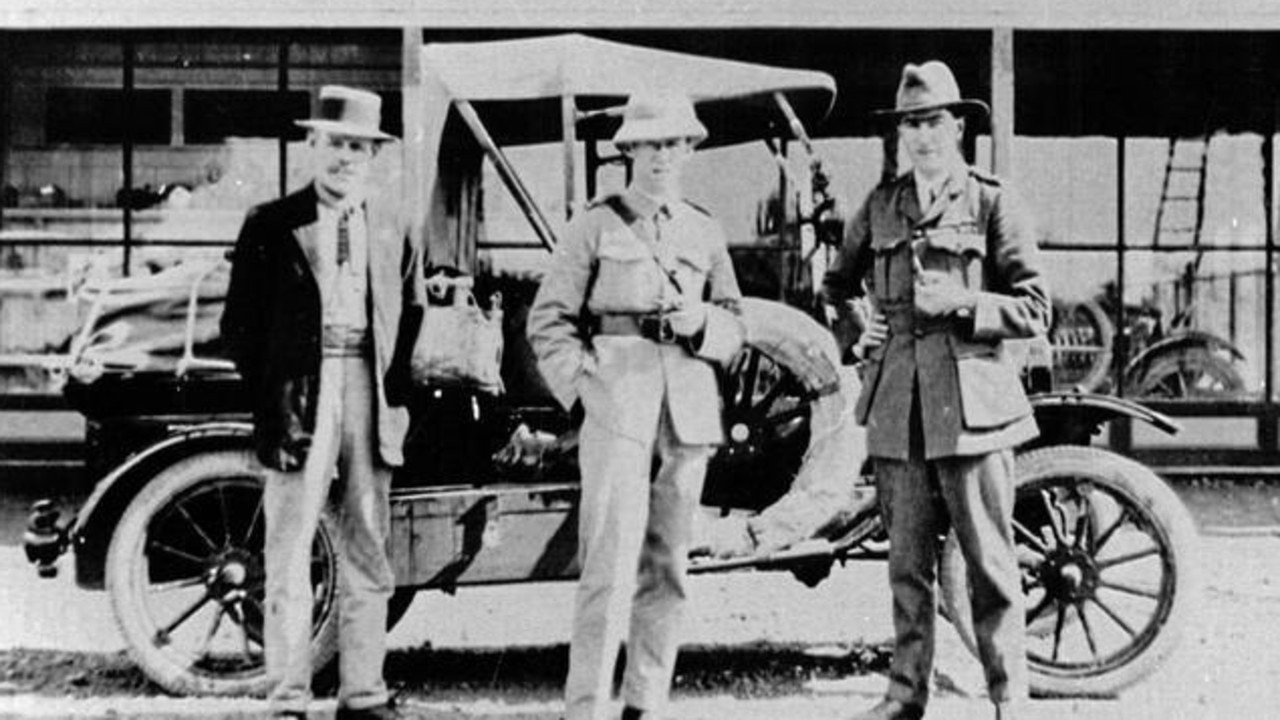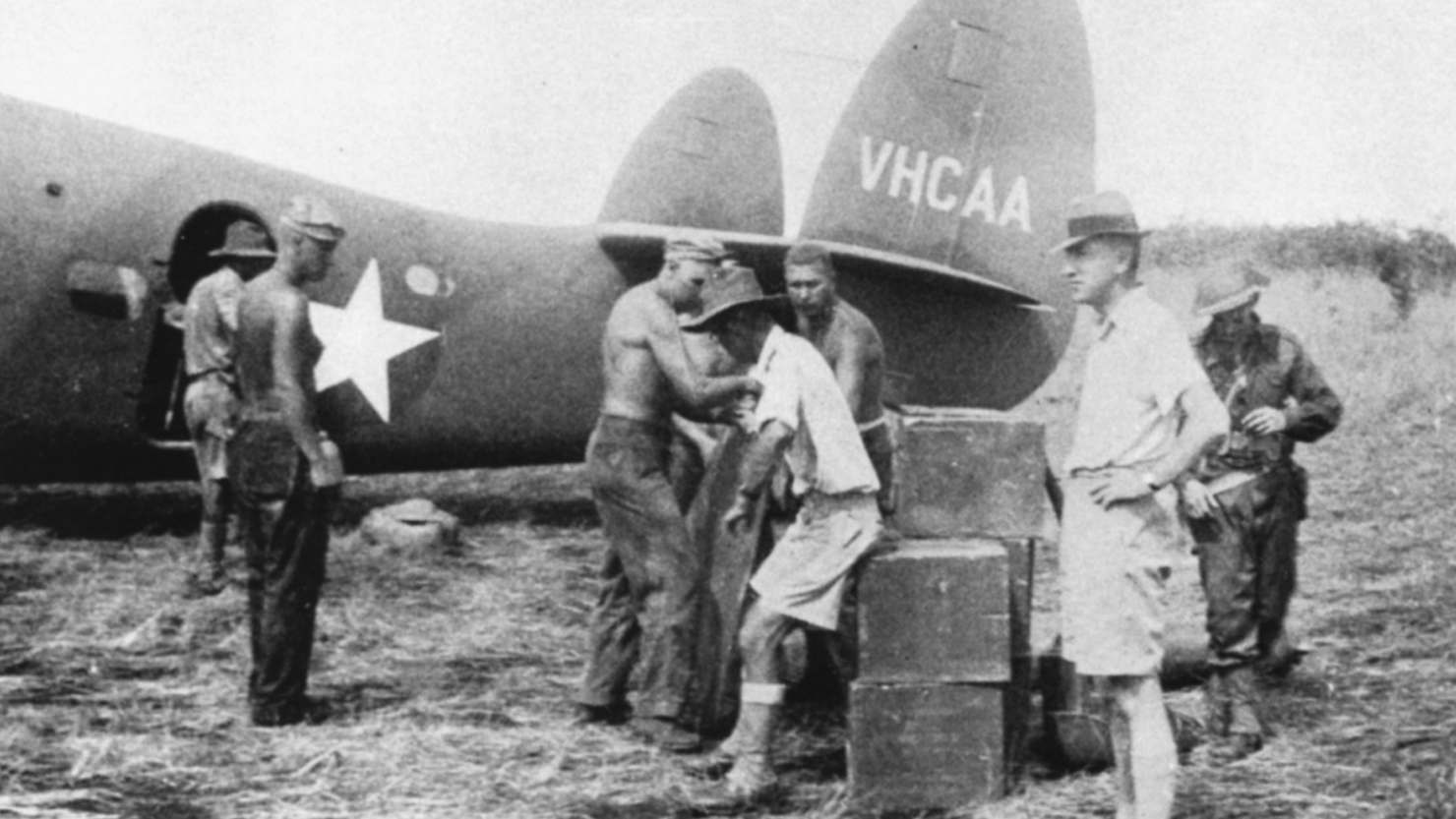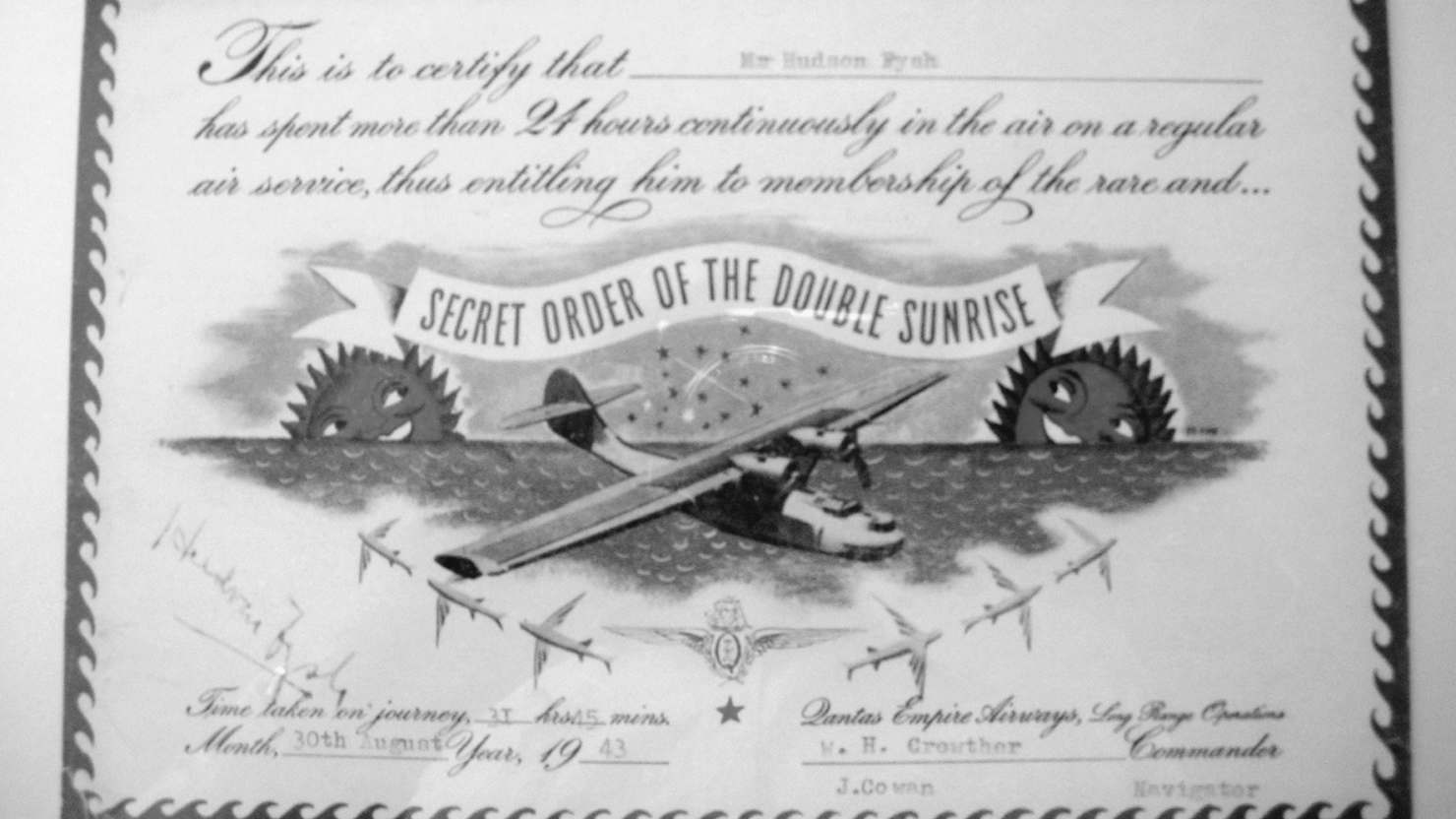In writing this article I am indebted to an elderly friend who was cleaning out his family home in preparation for a move to a retirement village. He gave me a book published in 1944 written by an ex-Qantas employee named E.Bennett-Bremner. He wrote it as a dedication to Qantas staff who served in perilous areas in the dark days of 1941 and 1942 and who received little or no recognition because they were all civilians.
In recent years Qantas has fallen from grace in the public perception for a variety of reasons but I think it is true to say that top management no longer enjoys the support of the public or its staff that made it the icon that it once was although shareholders should be eternally grateful. On reading this book one is again filled with pride at the loyalty, dedication to duty and the service to Australia by the staff of our national airline
These are the stories, recorded first hand, of various civilian staff members who carried on in the face of battles going on all around them and at great personal risk to themselves.
Episode 1: The formative years.
In March, 1919, the Commonwealth Government announced that it would give a prize of 10,000 pounds to the first Australian airman who could fly a British aeroplane or seaplane from England to Australia within 30 consecutive days. The offer remained open until 31st December, 1920.
In all 5 machines set off from England. Lieutenants Douglas and Ross crashed in their Alliance biplane 10 minutes after take-off. Captain Howell and Sergeant Fraser were drowned when their Sopwith biplane crashed into the Mediterranean. Captain Matthews and Sergeant Kay crashed in their Sopwith machine crashed in Bali. Sir Hubert Wilkins and Mr. Garnsey Potts developed engine trouble at Crete and abandoned their attempt. Two brothers, Ross and Keith Smith flying a Vickers Vimy bomber succeeded in reaching Australia in 28 days, won the prize and received knighthoods.
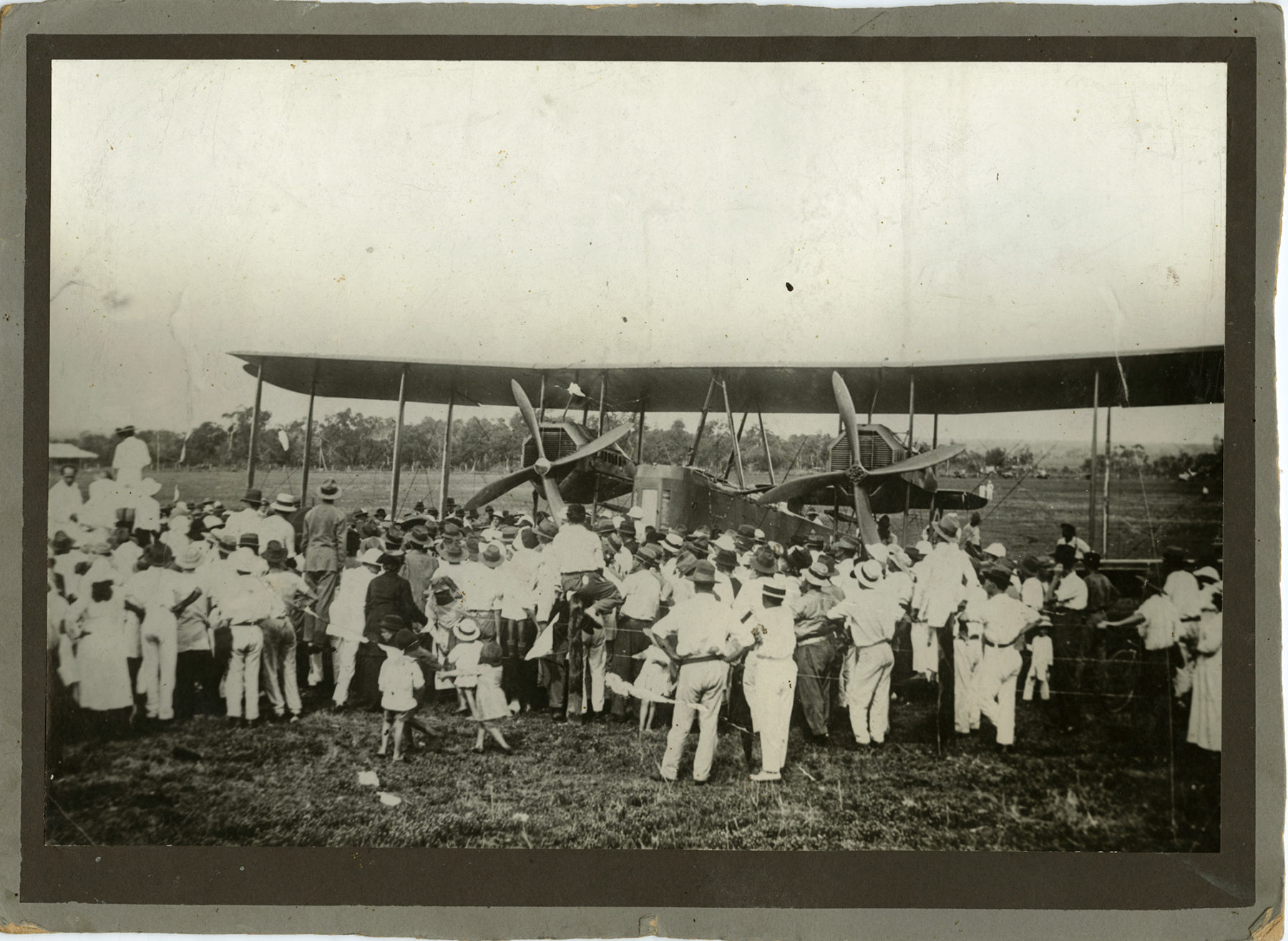
The Vimy arrives in Darwin, 10 December 1919. The Wet had begun, and fearing being bogged on the low-lying makeshift landing site, Ross Smith decided not to spend time overhauling the engines, but rather to head south in haste. Image credit: Keith Smith/State library of South Australia
Lieutenants Hudson Fysh and P.J.McGuiness, two WW1 veterans, entered the race but the sudden death of their backer, Sir Samuel McCaughey forced them to abandon any attempt. As a consolation prize, the Australian Government gave them a commission to survey a route across Australia for the use of any competitors who made the distance. The 11,340 mile journey was considered to be the most hazardous ever attempted up to that time and traversing the vast emptiness of the Australian outback was considered to be the most hazardous portion of this most hazardous journey.
Their task was to survey a route from Longreach to Darwin via the Gulf country. No car had ever travelled between Burketown and Borroloola. An alternative route across the Barkly Tableland also had a roadless stage between Newcastle Waters and Anthony’s Lagoon where no car had also ever traversed. Their task was to choose landing grounds and petrol and supply dumps along the chosen route. They set out in a “Tin Lizzie type Ford car and made the first car journey through the Gulf Country. Their work impressed them with the need for air transport in these remote and distant districts.
On reaching Darwin they concluded that the Gulf route was unsuitable and the inland track was chosen. Fysh remained in Darwin to undertake air route organisation while McGuiness returned to Cloncurry preparing landing grounds and dumps along the way. While waiting at Cloncurry for the Ross Smith flight to come through, McGuiness made the acquaintance of Fergus McMaster, a leading Queensland pastoralist and began discussion about the possibilities for commercial aviation. When Fysh returned to Cloncurry another pastoralist, Mr. Ainslie Templeton also became interested in the plan.
In November, 1920, Queensland and Northern Territory Aerial Services Limited was registered in Brisbane with a starting paid up capital of 6,850 pounds with Fergus McMaster as Chairman. The original business was for general air-taxi work and joy riding in Queensland. A ten minute ride cost 3/3/- and was enthusiastically received by the public most of whom had never even seen an aeroplane. Revenue rapidly rose. The acronym QANTAS was increasingly adopted.

The second objective was to link the Longreach and Winton railheads followed by linking Charleville, Blackall, Longreach, Winton and Cloncurry. At that time the rail journey from Longreach to Winton took four days and had to traverse 1,200 miles all to cover a distance of 117 miles as the crow flies. This journey was so long that few people used it and preferred to travel by car, a trip that took 5 hours over very rough roads but impassable in the wet season. The need for an air service was obvious.
The next objective was to extend the Southern end of the route to Brisbane and Sydney then the northern route to Darwin via Camooweal. In March, 1927 the company established the Brisbane Flying School at Eagle Farm Aerodrome. It secured the local agency for de Havilland aircraft and launched the beginning of sales of private-owner aircraft.
In May, 1928 the Flying Doctor Service was inaugurated using Qantas equipment and personnel followed by the commencement of building and flying its own aircraft under licence from de Havilland.

In 1931 Qantas joined with Imperial Airways Limited to offer the first official air mail service and the Darwin/Brisbane sector became a Qantas prerogative. Qantas Empire Airways (QEA)was registered in 1934 with McMaster as Chairman and secured the Singapore/Brisbane sector of the England to Australia service. The service was so successful that the former average of 5 to 100 pounds of mail per week rose to 11 tons per week with a need for bigger and heavier aircraft.
This presented a major problem. Airstrips around the world had been built to cater for WW1 type aircraft that did not require long or heavy runways. The new aircraft requirements demanded aircraft weighing up to 18 tons and, in addition, a need to be able to operate during tropical wet seasons in Africa and Australia with annual rainfalls of up to 150 inches. On top of that, housing and repair workshops needed to be provided for the bigger aircraft. The Qantas built DH 86 was suitable for the Singapore/Australia route but too small to carry the rising freight loads. A new solution had to be found and it was found in the flying boat.
The solution lay in the Short Empire Flying Boat designed by Short Brothers of England

Episode 2- The Flying Boat Era.
Flying boats provided the solution to all problems associated with bigger and more reliable services.
The obvious advantage was that they do not need extensive land infrastructure. Because they are supported on water their size is unlimited and the bigger they are the more seaworthy they become. The limitation to size was, of course, the need for enough engine power to get them into the air and remain there. The participants in the Empire airmail scheme decided on the Short Bros. Empire flying boat, a four engined high wing monoplane, and ordered 28 of them. Qantas bought six. After consulting the various Dominion and Colonial governments, the British Government decided that all first class mail from London to destinations within the Empire would be carried without surcharge. Qantas Empire Airways was the chosen operator of the Singapore/Sydney leg. A new route suitable for flying boat operations was established and the new service commenced on 5th July, 1938 operating thrice weekly.
A century ago, before the Second World War, travel was very different. Flying boats offered luxuries and facilities that have not been seen since, and the Boeing 314 was one of the most capable and successful of them. It had a glamourous but somewhat short life. But… What was this aircraft like? And why did it fall out of favor? A video of a flashback in time.
When war broke out in 1939 the air mail scheme was curtailed and the service reduced to twice weekly on a 13 day turn around. Bigger shocks were coming. It had for a long time been a regulation of the Dept. of Civil Aviation, that all members of civil flying staffs should also be members of the RAAF Reserve. On 20th September, following representations from the RAAF, two crews were signed up into the RAAF to operate flying boats under charter from QEA. Two flight crews together with engineers and ground staff were handed over in 5 days and left for active service in Northern Australia. More flying boats and crews were later transferred to the RAAF.
In April, 1940 the trans-Tasman service was inaugurated. QEA was one of the partners in the new Tasman Empire Airways service. In June of that year the fall of France and the entry of Italy into the war resulted in the first break in the through air route to London. And a new circuitous route was created from Sydney to Durban via India and Cairo until this route was also broken by Japan’s entry into the war.
In September, 1940 the RAAF had ordered a large batch of PBY Catalina flying boats from the Consolidated Aircraft Corp in San Diego, USA. Qantas was engaged by the RAAF to ferry these aircraft back to Australia for two reasons. First was that Qantas was the only organisation that had air crew trained and experienced in long distance flying. Second was that the USA was not involved in the war at that time and could not be seen to be providing these aircraft to a belligerent nation. One of the purchase conditions was that the aircraft be flown from San Diego to Honolulu by American pilots. There they would be handed over and become the property of the Australian Government.
The first delivery involved hops from Honolulu to Canton Island, Noumea and then Sydney. This was only the third flight ever to travel directly from the USA to Australia. All deliveries were completed successfully clocking up a distance of over 100,000 miles of which 40,000 were flown at night. One flight went direct from Canton Island to Sydney, a distance of 3,200 miles. All flights were staffed by Qantas crews diverted from the Sydney/ Singapore flying boat service. All flights were done with total co-operation from Pan-American Airways which, being a civilian organisation did not carry the constraints of US government neutrality.
Italy’s entry into the war created a significant strain on the demands for BOAC flight crews who were now required to operate the trans-Atlantic ferry service. On the 16th October, 1941, Qantas took over the complete operation of the Empire service as far as Karachi, 8,062 miles from Sydney.Additional stopping places were established at Koepang and Dili on Timor until 8th December when Japan entered the war.
Episode 3: The Japanese thrust.
In August, 1941 with Japan’s entry into the war being anticipated new bases were established throughout the Dutch East Indies and Malaya and new alternative routes surveyed to be used at short notice. These bases were all staffed by Qantas people and when Japan eventually did enter the war on 7th December, 1941 the services of QEA were able to continue but not without constant risk. Bombing raids in Singapore and Penang were carried out on a regular timetable and flight operations were timed so that arrivals and departures were scheduled when there were no Jap planes about. The composition of the payloads also changed. Rather than a preponderance of mail, civilian cargo and passengers the flights now carried more and more ammunition, weapons and refugees. Nearly all services leaving from Singapore for Java and Australia were “evacuee services”. Additional charter services were provided to the RAF carrying fuel and supplies to distant RAF stations.
Bombing raids on Singapore were constant and during which, approaching QEA planes would put down in the shelter of a nearby island until the all-clear was sounded and then proceed to the airport. Similar procedures were followed at other major locations and in nearly all cases flights were not scheduled at night due to risks of mis-identification of an incoming flying boat.
When the Johore Causeway was blown up on 30th January, 1942 Dutch services stopped.
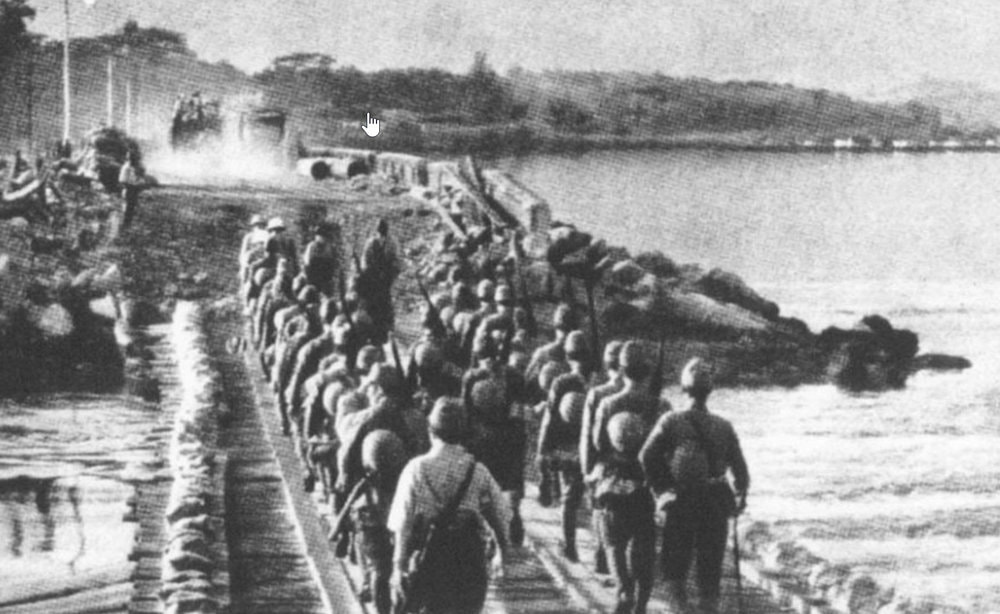
Qantas was the last remaining service. Its last flight into Singapore was on the 3rd February and it departed at 2.30am the following morning with 30 passengers on board. As the Japanese advanced on the CBD the Qantas manager was arranging the evacuation of office staff. The company launch was used to ferry passengers to ships in the harbour due to leave on the night of Friday 13th February. On 14th Feb eleven remaining staff set out in the company launch headed for the West coast of Sumatra then on to Tjilatjap on the south coast of Java where there was a shuttle service operating to Broome, WA. The last flying boat had left the previous morning and the party were lucky to get berths on a Dutch ship, Zandam, which arrived safely in Fremantle on 6th March.
Qantas first major casualty occurred on 30th January when the flying boat Corio left Darwin on a special flight to collect women and children refugees from Sourabaya on Java. Approaching Koepang on Timor theplane was attacked by 7 Japanese Zeros and shot down. Of 18 occupants, 7 escaped into the sea, five made it to the beach. They were rescued by a Dutch Dornier flying boat and finally made it to Darwin.
On 14th February, 1942 the following message was received from the RAF Director of Fighter Operations.
“Flying boats are to stop at Batavia and Calcutta until further notice, as parachute troops landed at Palembang. Contact Millar of BOAC. Flying boats are not to proceed east of Calcutta or west of Batavia until further notice.”
The Broome/Java shuttle service was then established. On 19th February Darwin was attacked in two Japanese air raids.

These attacks are described with in two previous articles but it is suffice to say that Qantas emerged from them with little damage. Its hanger at the civilian airport was totally destroyed but there were no planes inside. The flying boat Camillawas moored in theharbour but it,and the company launch were untouched. The QEA passenger launch was sunk when the big explosion at the wharf occurred but overall no Qantas staff were lost in the raid.
On 27th February two flying boats flew from Broome to Tjilatjap to collect evacuees unescorted and unarmed. They left the following day but only one arrived at Broome. The other, Circe, was never heard of again.
Broome proved to be a very difficult location for a flying boat base. There was a 32 foot rise and fall of tide so flying boats had to be moored in deep water about 1 ½ miles out. There was a long jetty but at low tide it was 30 feet high and all baggage to be loaded had to be carried manually through mud flats. Luggers were used for refuelling but could only operate at high tide,and could only hold enough fuel for one flying boat. The town was overcrowded with refugees and there was no accommodation for staff or offices.
On 3rd March, 1942, there were 14 different types of flying boats at Broome and over 1,000 Dutch refugees congregated at Broome. The flying boats were nearly all Dutch, the Dutch government having instructed its airlines to evacuate all aircraft and take their families with them to Broome. Hudson Fysh had instructed his pilots that only one QEA flying boat was to be at Broome at any one time in anticipation of a Japanese attack. Flying boats approaching Broome had to divert to Wyndham until the aircraft at Broome had left. Onthat morning, nine Jap Zeros attacked Broome. All flying boats at moorings and six land based aircraft of the adjacent US Air Force base were destroyed. All up 22 Allied aircraft and at least 88 people were killed in the attack which lasted for one hour. Qantas lost one boat plus another that was on charter to the RAAF.
About an hour after the raid the QEA flying boat Camilla arrived and was immediately told to leave to some remote spot as a second raid was expected. That did not happen and the next morning Camilla began evacuating the survivors to Port Headland. She then began a shuttle service between Broome and Port Headland evacuating all civilians, US Navy, BOAC and Qantas personnel. Camilla made one final trip to Broome to load all valuable aircraft and engine spares for transfer to the Qantas base in Sydney.
The Japanese attacks throughout Northern Australia not only brought the empire mail services to an end but caused severe curtailment on domestic routes as well. Land based aircraft were commandeered at short notice by the RAAF and those flights that were made had full loads of ammunition and small arms for the defending units.
Mission to Mt.Hagen:
Mount Hagen is deep in the Owen Stanley Range in New Guinea and is the main town of the NG Highlands.
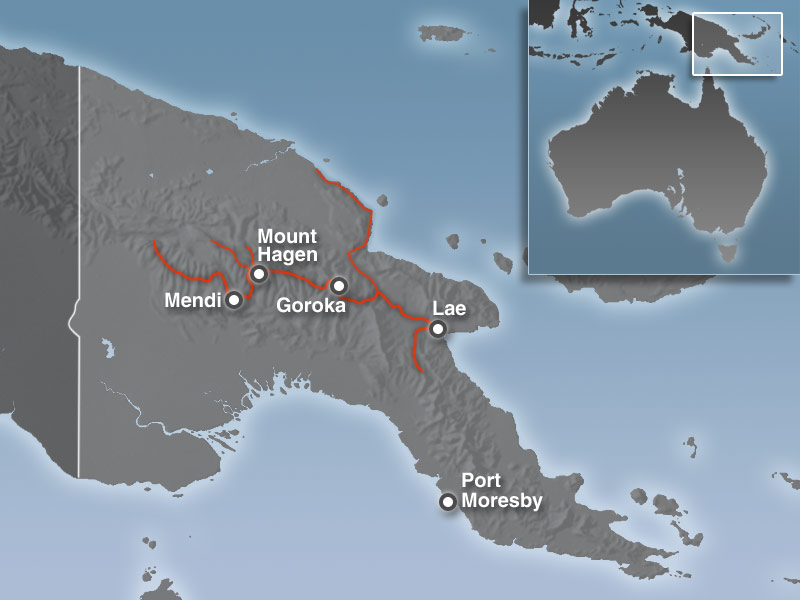
Father Glover, a priest at the local mission had a pilot’s licence and had been flying people out in his small aircraft after the Japs invaded the north coast beaches. He crashed his plane but knew of another one at the Alexishafen mission station situated behind Jap lines. He and an engineer walked overland, got the plane and flew it to Mt.Hagen. He had 90 people to evacuate and realised it was too many for his small plane so he decided to fly to Melbourne for help. He got blown off course, ran out of petrol and made a forced landing on the south coast of Papua. Helped by friendly natives in a canoe, a lugger then a motor launch, he got to Thursday Island and then on to Melbourne. The authorities engaged QEA to undertake the rescue.
Two Qantas DC86s formerly owned by Qantas but now chartered to the RAAF were loaned from the RAAF with full Qantas crews. They had been used on the Brisbane/Singapore service and had long range tanks. They set up a base at Horne Island. The strip at Mt.Hagen was 1,000 yards long but had a soft surface. To enable bigger loads safely, Father Glover organised the local population of 26,000 natives into groups of 2,000 who then marched up and down the strip non-stop for 24 hours stomping on the ground to make it firmer. There was no payment. 18 round trips were made dodging bad weather over the highlands and raids by Jap planes on Port Moresby. After the evacuation to Horne Island was completed, QEA was asked to fly 30 evacuees who could not fit on board a ship down to Cairns. This was done in two round trips. The crew returned to Brisbane 14 days after they set out to complete the task without a hitch in these unarmed and unescorted passenger aircraft.
SW Pacific Campaign:
Although much of the Qantas land based services were in disarray the Brisbane/Darwin services were augmented by RAAF charters of flying boats to carry equipment and personnel to the northern areas. These charters extended to Port Moresby and Vila. In April, 1942 five trips were made to Milne Bay carrying fresh troops in and wounded soldiers out. 5 1/2 tons of freight and 116 soldiers were delivered on these trips. In July and August Qantas flying boats were in constant use under Air Transport Command and the RAAF carrying personnel and freight to the front lines at Port Moresby and Milne Bay with the heat of the4se battles going on around them and again, without escorts and unarmed. These flights started at Townsville with a stop at Cairns. This enabled the 75 minutes flying time of fuel to be replaced by another 1,000 pounds of freight.
Departures from Moresby were made at night. Arrivals were timed so that they arrived after the daily raid of Jap bombers had finished their task. Trips to Milne Bay were timed accordingly. Strict radio silence was observed at all times and on approach communication was made via Aldis lamps.
In the midst of this action a weekly service was commenced to Noumea interrupted only by urgent demands for aircraft.
As the Japs advanced through the Dutch East Indies the Dutch government instructed its domestic carriers, KLM and KNILM, to fly their planes to Australia. These aircraft were then purchased by the US Army Air Corps for wartime transport. The USAAC crews could not handle these civilian aircraft and some were lost in mishaps. The Australian civil airlines could not procure modern aircraft as the overseas manufacturers were fully committed to their own country defence needs. Thus the Australian airlines had a surplus of experienced crews without aircraft. The Allied Directorate of Air Transport proposed that the Australian airlines take over these aircraft and operate them on behalf of the USAAC. Qantas received three Lockheed Lodestars under this scheme. The planes carried US markings and call signs with the Qantas name on the nose.
The first flights were to Port Moresby but as the Japs were pushed back to the beachhead at Buna/Gona and provided unexpected strong resistance. From November, 1942 Qantas, ANA and Guinea Airways were providing regular and frequent services to rudimentary landing strips close to the front line. Men and supplies were being brought in and wounded troops taken out. As the battles continued on to Sananander the flights continued by dropping supplies to the Australian and American units. Where practicable fighter cover was provided but the majority of these flights were unescorted. Thirteen dropping flights were made in this way and another five landing at Poppendetta and Dobodura in the first week of operations. The Lodestar flights were supplemented by DH86s. Attacks by Jap Zeros and Jap ground small arms fire damaged some flights but not seriously. The cloudy weather in the mountainous terrain gave good protection against air attacks but the proximity of the landing strips to the front lines meant that there was always a risk of being hit by ground fire.
While all this supply service was going the fortnightly flying boat services between Port Moresby and Darwin continued. Hudson Fysh came to Port Moresby in December, 1942 to inspect the work Qantas was doing. He was asked by General Kenny, the Co of the USAAC “How are you able to operate such a regular service?”
Hudson Fysh (second from right) pictured during the loading of Qantas aircraft at Port Moresby.
Fysh replied “Because maintenance is based on a properly equipped and staffed base at Sydney where an adequate supply of spares exists and because veteran crews are employed whose job it is to get there safely.”
At that time the Buna/Gona campaign was at its height. The strip at Port Moresby was full of aircraft. General Kenny on one day had set a task that every available air transport plane in Australia was engaged to carry several million pounds of supples to the Buna area. In one day 400,000 pounds of freight was uplifted to Buna and the following day 500,000 pounds were carried. About one seventh of this cargo was carried by the civil air transports. Hudson Fysh himself took part in some of these flights. The most experienced captain in New Guinea flying conditionswas Qantas Captain Orme Denny who, as well as flying himself daily, was engaged as an advisor to HQ of US Air Transport Command.
Catalinas to the Rescue:
The curtailment of services to Singapore and beyond by the advance of Japanese forces left a gap in the communications links of the Empire. Hudson Fysh proposed that Qantas, using its Catalinas, could open a service across the Indian Ocean to Africa to connect with BOAC services to that continent. These proposals were rejected by the Dept. of Civil Aviation. Appeals to the Prime Minister and the Governor General by Fysh got him into hot water for going over the head of the department.
Hudson Fysh however had been in constant contact with BOAC and the British government on a variety of matters affecting the advancement of air services in general and overcoming the disruptions caused by the war. On 22nd April, 1942, the British Director-General of Civil Aviation informed Fysh that the British government had approved a plan by BOAC to operate an Indian Ocean service with four of their Catalinas to be operated by Qantas. This was an entirely BOAC initiative using BOAC aircraft so that the Australian department had no jurisdiction in the decision. This service was conducted in great secrecy between Perth and Ceylon (now Sri Lanka) as it crossed territory under Jap control for brief periods. Staff were not allowed to wear Qantas uniforms or discuss their flights with anybody on shore in Australia. In 1944 the service was extended to Karachi and was commonly known as the Double Sunrise flights such was the duration of each trip. Passengers who took these flights were handed a certificate named the Secret Order of the Double Sunrise.
The service made 271 crossings of the ocean delivering 4 tons of mail and 800 passengers. The flights were unescorted and unarmed with only one close shave when a Catalina was refuelling at Cocos Island on 14th February, 1944. A single Jap plane dropped a bomb and missed then flew off.
Once the Japanese retreated from Burma and SE Asia, normal services were resumed and the Indian Ocean crossings were no longer required.
The Aftermath:
As the war in the Pacific and SE Asia contracted back to the Japanese home islands flying boat services were restored. However, in the wake of the American naval island hopping strategy, Pan Am had been able to established routes to places that one might have assumed to be within the ambit of QEA exclusivity.
One route in particular where QEA stood out was the service to Chile flown by Catalinas pioneered by Capt. P.G.Taylor. This non-stop flight across the Pacific was the longest scheduled route undertaken by any airline in the world at the time.
During the course of the war Qantas lost all of its Empire flying boats. Five were lost under Qantas control, the rest while on charter to the RAAF and USAAF. A re-equipment with Short Sunderland flying boats, the mainstay of British Coastal Command, was undertaken but the construction of airfields in former battle zones increased the availability of land based destinations.
There was one enduring legacy which Qantas retained from the war. That was the maintenance bases at Sydney and Brisbane. After the fall of Malaya, Java and Singapore many BOAC aircraft and staff moved to Australia. Qantas created a major engine overhaul facility at Mascot which steadily expanded to become to key major maintenance facility for all allied aircraft operating out of and near to Australia. By war’s end the maintenance staff at Mascot had grown to eight times its pre-war strength. Not only in volume but the variety of engine and aircraft types that were serviced increased immensely. In addition, instrument repair and maintenance was carried out at Mascot and Brisbane, facilities which have carried on until the present day.
As a result of the war Qantas could have been described as an airline without an airline but as an organisation, it persisted and prevailed.
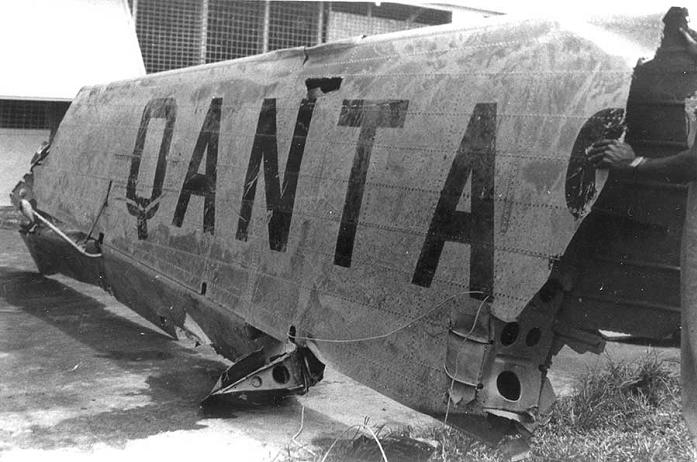
The post war recognition of the efforts of Qantas and its civilian staff by the government could only be described as miserable. Apart from Qantas personnel who were recruited into the RAAF, only five captains received any kind of formal recognition for their war time services undertaken willingly as civilians flying in dangerous air space alongside RAAF and USAAF personnel. When one compares the numbers of awards handed out to serving RAAF personnel with what was directed to Qantas air crews the performance of the then Labour government can only be described as pathetic. Six ex Qantas pilots flying with the RAAF were granted decorations.
To add further insult to injury the Chifley government, embarking on a policy of nationalisation of all major industry, passed the Australian national Airlines Bill in August, 1945. This was challenged in the High Court with limited success by Ivan Holyman, the owners of ANA. After the delay of the court proceedings, in August 1946 the government passed another bill called The Qantas Empire Airways Agreement whereby the airline became wholly owned by the Commonwealth government. The shareholders were paid a pittance for their investment and the management was superseded by a collection of government appointed executives although Hudson Fysh retained operational control for some years.
No recognition of the contribution of the organisation’s war efforts has ever been raised.
BLOG COMMENTS POWERED BY DISQUS


